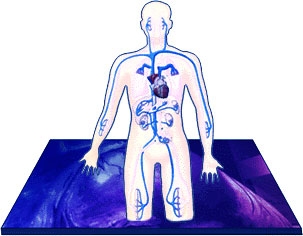Veins are similar to arteries but, because they transport blood at a lower pressure, they are not as strong as arteries. Like arteries, veins have three layers: an outer layer of tissue, muscle in the middle, and a smooth inner layer of epithelial cells. However, the layers are thinner, containing less tissue.
Veins receive blood from the capillaries after the exchange of oxygen and carbon dioxide has taken place. Therefore, the veins transport waste-rich blood back to the lungs and heart. It is important that the waste-rich blood keeps moving in the proper direction and not be allowed to flow backward. This is accomplished by valves that are located inside the veins. The valves are like gates that only allow traffic to move in one direction.
The vein valves are necessary to keep blood flowing toward the heart, but they are also necessary to allow blood to flow against the force of gravity. For example, blood that is returning to the heart from the foot has to be able to flow up the leg. Generally, the force of gravity would discourage that from happening. The vein valves, however, provide footholds for the blood as it climbs its way up.

Blood that flows up to the brain faces the same problem. If the blood is having a hard time climbing up, you will feel light-headed and possibly even faint. Fainting is your brain's natural request for more oxygen-rich blood. When you faint, your head comes down to the same level as your heart, making it easy for the blood to quickly reach the brain. Because it lacks oxygen, the waste-rich blood that flows through the veins has a deep red color, almost like maroon. Because the walls of the veins are rather thin, the waste-rich blood is visible through the skin on some parts of the body. Look at your wrist, or hands, or ankles. You can probably see your veins carrying your blood back to your heart. Your skin refracts light, though, so that deep red color actually appears a little blue from outside the skin.

